Pippi Longstocking
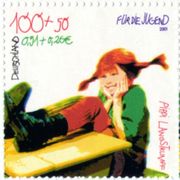
Pippi Longstocking (Swedish Pippi Långstrump) is a fictional character in a series of children's books by Swedish author Astrid Lindgren, and adapted into multiple films and television series. Pippi was named by Lindgren's then nine-year-old daughter, Karin, who requested a get-well story from her mother one day when she was home sick from school.
Nine-year-old Pippi is unconventional, assertive, and has superhuman strength, being able to lift her horse one-handed without difficulty. She frequently mocks and dupes adults she encounters, an attitude likely to appeal to young readers; however, Pippi usually reserves her worst behavior for the most pompous and condescending of adults. She turns white around the nose whenever she gets angry, which in view of her superhuman strength thankfully happens very rarely. Pippi's anger is reserved for the most extreme cases, such as when a man ill-treats his horse. And like Peter Pan, Pippi does not want to grow up.
After an initial rejection from Bonnier Publishers in 1944, Lindgren's manuscript was accepted for publication by the Swedish publisher Rabén and Sjögren. The first three Pippi chapter books were published from 1945 to 1948, with an additional series of six books published in 1969–1975. Two final stories were printed in 1979 and 2000. Time Magazine named the original book as one of the most influential one hundred novels. The books have been translated into 64 languages.[1]
Contents |
Pippi and her world
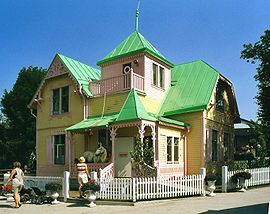
Pippi claims her full name is Pippilotta Delicatessa Windowshade Mackrelmint Ephraim's Daughter Longstocking (Swedish: Pippilotta Viktualia Rullgardina Krusmynta Efraimsdotter Långstrump). Her fiery red hair is worn in braids that are so tightly wound that they stick out sideways from her head.
Pippi lives in a small Swedish village, sharing the house she styles "Villa Villekulla" with her monkey, Mr. Nilsson, and her horse (nameless in the books, but in adaptations usually referred to as "Old Man"), but no adults or relatives. She befriends the two children living next-door: Tommy and Annika Settergren. The three have many adventures. Tommy and Annika's mother, Mrs. Settergren, often disapproves of Pippi's sometimes coarse manners and lack of education, but eventually comes to appreciate that Pippi would never put Tommy and Annika in danger, and that Pippi values her friendship with the pair above almost anything in her life. Pippi's two main possessions are a suitcase full of gold coins (which she used to buy her horse) and a large chest of drawers containing various small treasures.
Though lacking much formal education, Pippi is very intelligent in a common-sense fashion, has a well-honed sense of justice and fair play, and has learned from a wide variety of experiences. She will show respect (though still in her own unique style) for adults who treat her and other children fairly. Her attitude towards the worst of adults (from a child's viewpoint) is often that of a vapid, foolish and chatterbox of a child, with most of her targets not realizing just how sharp and crafty Pippi is until she's made fools of them. Pippi has an amazing talent for spinning tall tales, although she normally does not lie with malicious intent; rather, she tells truth in the form of humorously strange stories.
In several of the movies Pippi is shown to be a superb swimmer. She'll think nothing of taking a plunge while fully clothed in her short patchwork dress with oversized shoes and mismatched thigh-high stockings.
Pippi is the daughter of seafarer Ephraim Longstocking, captain of the sailing ship Hoptoad (Hoppetossa in Swedish), from whom Pippi inherited her common sense and incredible strength. Captain Longstocking is the only person known who can match Pippi in physical ability. He originally bought Villa Villekulla to give his daughter a more stable home life than that onboard the ship, although Pippi loves the seafaring life and is a better sailor and helmsman than most of her father's crew. Pippi retired to the Villa Villekulla after her father was believed lost at sea, determined in her belief that her father was still alive, had been made an island king, and would come to look for her there.
As it turned out, Captain Longstocking was washed ashore upon a South Sea island known as Kurrekurredutt Isle, where he was made the "fat white chief" by its native people. The Captain returned to Sweden to bring Pippi to his new home in the South Seas, but Pippi found herself attached to the Villa and her new friends Tommy and Annika, and decided to stay where she was, though she and the children sometimes took trips with her father aboard the Hoptoad, including a trip to Kurrekurredutt where she was confirmed as the "fat white chief's" daughter, Princess Pippilotta.
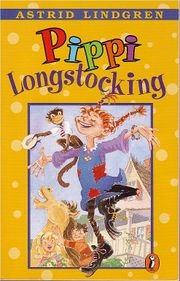
Pippi's unusual strength
Pippi's strength has been described in various ways:
- "The strongest human being in the world."
- "She is so strong you won't believe it!"
- In one of the books, she is described as having "The strength of ten policemen."
- On a VHS cover she is described as "The Girl With The Strength Of Superman"
She is also seen in the various movies picking up a horse (the books often mention Pippi moving her horse Old Man by carrying him from one place to another), a car, weights/barbells weighing over 1,000 pounds, a weightlifter carrying weights/barbells weighing over 1,000 pounds; she also pulls bars out of a jail window and throws pirates across a room.
Books
There are three full length Pippi Longstocking books:[2]
- 1945: Pippi Longstocking
- 1946: Pippi Goes on Board
- 1948: Pippi in the South Seas
There were three original picture books that were translated into English:[3]
- 1971: Pippi on the Run
- 1950: Pippi's After Christmas Party
- 2001: Pippi Longstocking in the Park
There are many picture books and short books based on chapter excerpts from the original three including:
- Pippi Goes to School (1999)
- Pippi Goes to the Circus (1999)
- Pippi's Extraordinarily Ordinary Day (1999)
Adaptations
The 1949 movie
The first movie adaptation of Pippi Longstocking was filmed in 1949. The film was based on three of the books, but several storylines were changed and characters were removed and added. Pippi's character was played by Viveca Serlachius, who made 10 other movies between 1944 and 1954. It was directed by Per Gunvall and released on October 20, 1950.
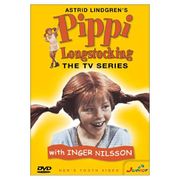
The 1961 Shirley Temple's Storybook Episode
In 1961 the American children's anthology TV series Shirley Temple's Storybook (hosted by Shirley Temple) included an adaptation of Pippi Longstocking, Episode 2-15, aired on January 8. This is the earliest American adaptation of Astrid Lindgren's character. Gina Gillespie played the title role, and, in a dual role, a character named Susan Scholfield. Also of note is Swedish wrestler/actor Tor Johnson, in one of his final roles, playing a strongman at a carnival Pippi goes to.[4]
The 1969 version
A Swedish Pippi Longstocking television series was created based on the books in 1969. The first episode was broadcast on Sveriges Radio TV in February 1969. The production was a Swedish-West German co-production and several German actors had roles in the series.
As Astrid Lindgren was unhappy with the 1949 adaptation, she wrote the script herself for this version. The series was directed by Olle Hellbom who also directed several other Astrid Lindgren adaptations. Inger Nilsson gave a confident oddball performance that was uncommonly consistent and eccentric for a child actress.
This version is the most well known version in Sweden and has been repeated numerous times by SR/SVT. In other European countries this is the most favored version of Pippi Longstocking.
The Swedish series was re-edited as four dubbed feature films for U.S. distribution:
- Pippi Longstocking (Pippi Långstrump, 1969)
- Pippi Goes on Board (Här kommer Pippi Långstrump, 1969)
- Pippi in the South Seas (Pippi Långstrump på de sju haven, 1970)
- Pippi on the Run (På rymmen med Pippi Långstrump, 1970)
They became weekend television staples in several cities in the United States throughout the 1970s and 1980s. The original TV series, newly dubbed using British actors, became available on DVD in 2002.
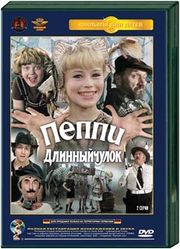
The Soviet television film
A Mosfilm television film version, Peppi Dlinnyychulok, was released in 1982. It was produced by Margaret Mikalan, and starred Mikhail Boyarsky, Lev Durov and Tatiana Vasilieva. Pippi was played by Svetlana Stupak, and her singing voice was provided by Svetlana Stepchenko.[5]
The ABC Weekend Special TV special
In 1985, Carrie Kei Heim played the title role in the 2-part ABC Weekend Special, entitled Pippi Longstocking. Directed by veteran special effects wizard Colvin Chilvers, Part 1 of the special aired on November 2, and Part 2 aired on November 9.[6]
The American feature film
An American feature film version from Columbia Pictures was released in 1988, directed by British veteran director Ken Annakin, starring Tami Erin as Pippi with Eileen Brennan, Dennis Dugan, John Schuck and Dick Van Patten in supporting roles. While the title suggests a continuation, the film is in fact just a retelling of the original story.
The Animated Pippi
An animated film adaptation by Nelvana, Pippi Longstocking, was released in 1997 and was adapted into an animated television series, Pippi Longstocking by Nelvana, which aired for two seasons (1997–1999) on HBO in the United States and Canada's Teletoon channel. A Sequel to the first animated film, Pippi Longstocking: Pippi's Adventures On The South Seas followed in 2000. Reruns are shown on the qubo digital subchannel.
Hayao Miyazaki's aborted anime film
In 1971, Japanese animators Hayao Miyazaki and Isao Takahata had expressed great interest in doing an anime feature adaptation of Pippi Longstocking. The proposed project was titled Pippi Longstocking, The Strongest Girl In The World (長靴下のピッピ 世界一強い女の子 - Nagakutsushita No Pippi, Sekai Ichi Tsuyoi Onna No Ko). They traveled to Sweden, and not only did research for the film (they went location scouting in Visby, one of the major locations where the 1969 TV series was filmed), but also personally visited creator Astrid Lindgren, and discussed the project with her. Unfortunately, after their meeting with Lindgren, their permission to complete the film was denied, and the project was canceled. Among what remains of the project are watercolored storyboards by Miyazaki himself. [7]
Name in other languages
The book of Astrid Lindgren was translated in over 70 languages. This section lists the character's names in languages other than English.
- In Afrikaans "Pippi Langkous"
- In Albanian "Pipi Çorapëgjata"
- In Basque "Pipi Galtzaluze"
- In Belarusian "Піпі Доўгаяпанчоха"
- In Bosnian "Pipi Duga Čarapa"
- In Bulgarian "Пипи Дългото Чорапче"
- In Catalan "Pippi Mitgesllargues"
- In Chinese "长袜子皮皮"("Changwazi Pipi")
- In Croatian "Pipi Duga Čarapa"
- In Czech "Pipi Dlouhá Punčocha"
- In Danish "Pippi Langstrømpe"
- In Dutch "Pippi Langkous"
- In Esperanto "Pipi Ŝtrumpolonga"
- In Estonian "Pipi Pikksukk"
- In Finnish "Peppi Pitkätossu"
- In French "Fifi Brindacier"
- In Georgian "Pepi Magalitsinda"
- In German "Pippi Langstrumpf"
- In Greek "Πίπη Φακιδομύτη" ("Pipe Phakidomyte")
- In Hebrew "בילבי בת-גרב" ("Bilbi Bat-Gerev"), "גילגי" ("Gilgi") in old translations
- In Hindi "Pippi Lambemoze"
- In Hungarian "Harisnyás Pippi"
- In Icelandic "Lína Langsokkur"
- In Indonesian "Pippi Si Kaus Panjang"
- In Irish, it is the same as English "Pippi Longstocking"
- In Italian "Pippi Calzelunghe"
- In Japanese "長靴下のピッピ" ("Nagakutsushita no Pippi")
- In Korean "말괄량이 소녀 삐삐" ("Malgwallyang'i Sonyŏ Ppippi")
- In Kurdish "Pippi-Ya Goredirey"
- In Latvian "Pepija Garzeķe"
- In Lithuanian "Pepė Ilgakojinė"
- In Macedonian "Пипи долгиот чорап"
- In Norwegian "Pippi Langstrømpe"
- In Persian "پیپی جوراببلنده" ("Pipi Joorab-Bolandeh")
- In Polish "Pippi Pończoszanka" or "Fizia Pończoszanka"
- In Portuguese "Píppi Meialonga" (Brazil), "Pipi das Meias Altas" (Portugal)
- In Romanian "Pippi Şoseţica"
- In Russian "Пеппи Длинный Чулок" ("Peppi Dlinn'iy Chulok)" or "Пеппи Длинныйчулок" ("Peppi Dlinn'iychulok")
- In Serbian "Pipi Duga Čarapa"
- In Slovak "Pipi Dlhá Pančucha"
- In Slovenian "Pika Nogavička"
- In Spanish "Pipi Calzaslargas" (Spain) or "Pippi Mediaslargas" and "Pepita Mediaslargas" (Latin America)
- In Sinhalese "දිගමේස්දානලාගේ පිප්පි" ("Digamasedaanalaagee Pippi")
- In Swedish "Pippi Långstrump" (Original)
- In Thai "Pippi Thung-Taow Yaow"
- In Turkish "Pippi Uzunçorap"
- In Ukrainian "Пеппі Довгапанчоха" ("Peppi Dobhapanchokha")
- In Vietnamese "Pippi Tat Dai"
- In Welsh "Pippi Hosan-hir"
- In Yiddish "פּיפּפּי לאָנגסטאָקקינג" ("Pippi Longstocking")
References
- ↑ http://www.astridlindgren.se/varlden-runt/astrid-i-varlden
- ↑ "Astrid (Ericsson) Lindgren." Major Authors and Illustrators for Children and Young Adults, 2nd ed., 8 vols. Gale Group, 2002. Reproduced in Biography Resource Center. Farmington Hills, Mich.: Gale, 2008. http://galenet.galegroup.com/servlet/BioRC (requires login)
- ↑ "Astrid (Ericsson) Lindgren." Major Authors and Illustrators for Children and Young Adults, 2nd ed., 8 vols. Gale Group, 2002. Reproduced in Biography Resource Center. Farmington Hills, Mich.: Gale, 2008. http://galenet.galegroup.com/servlet/BioRC (requires login)
- ↑ http://www.imdb.com/title/tt0699612/
- ↑ http://www.imdb.com/title/tt0263853/
- ↑ http://www.imdb.com/title/tt0344205/
- ↑ http://www.ghibliworld.com/news.html#0405
External links
- Pippi Longstocking and Astrid Lindgren
- The Adventures of Pippi Longstocking launches on YTV, Fall 2006
- Japanese stage musical starring Tomoe Shinohara (Japanese)
|
|||||||||||||||||